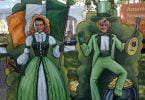
Rwandan genocide survivor Immaculee Ilibagiza has become an American citizen. A best-selling author, Ilibagiza has given talks around the country about the 1994 slaughter in her home country and how her Catholic faith and trust in God helped her survive. She is seen in a 2012 photo at the papal villa in Castel Gandolfo, Italy. (CNS photo/Paul Haring) (April 18, 2013)
by Jill Ragar Esfeld
jill.esfeld@theleaven.org
When I had the privilege of interviewing Immaculée Ilibagiza years ago, I asked her if she really did long to be back in the bathroom.
I asked because that single reflection in her first book “Left to Tell” was the part of her story that struck me the most.
She said that oftentimes she did.
For those of you who aren’t familiar with Immaculée’s story, she survived the 1994 Rwandan genocide by hiding in a tiny bathroom with seven other women for three months.
They were members of the Tutsi population, being hunted for extinction by the Hutu-led government in the East-Central African nation of Rwanda.
During the time Immaculée was in hiding, an estimated 800,000 people were massacred, including her entire family save one brother.
Immaculée and the women she hid with had to maintain complete silence during those three months, for fear of being discovered.
They subsisted on what few scraps of leftover food their protector could sneak to them. Immaculée lost 60 pounds.
It’s a diet no one would envy.
Besides the clothes on her back, Immaculée had only one possession in that bathroom – her father’s rosary. And she prayed it constantly.
She told me she was so united to the suffering of Christ while she was in that place of fear and silence that sometimes, caught up in the commotion of her new life, she longed to be there again.
I understood that.
Though my experiences of suffering have been nothing compared to Immaculée’s, I’ve had enough to know how the anxiety suffering generates can strip away all temporal thought and unite you to Jesus.
And sometimes, when you’re in that moment of placing yourself completely in the hands of God, it is a paradoxically beautiful experience.
It really is the upside of suffering.
It’s no surprise that to this day Immaculée has a great devotion to the rosary. And her favorite is the Rosary of the Seven Sorrows — a meditative prayer of Mary’s suffering with Jesus dating back to the 13th century.
It is the rosary extolled by Our Lady of Kibeho, a Marian apparition in Rwanda approved by the Catholic Church.
During Mary’s appearance to visionary Marie-Claire Mukangango, she asked that the Rosary of the Seven Sorrows be reintroduced to the world.
After reading Immaculée’s books, the Rosary of the Seven Sorrows has become a favorite meditation of mine, especially during Holy Week and particularly during the three hours Jesus suffered on the cross.
I think of Immaculée on Good Friday. I think of her silent and praying in that tiny bathroom. I try to find a similar place where I can be alone and silent with Mary — really uniting myself with the suffering of Jesus.
There are many places on the Internet where you can get instructions for the Seven Sorrows Rosary. Immaculée’s favorite version (and mine, too) is in her book “Our Lady of Kibeho.” It can be found here.






